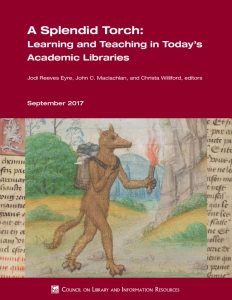Contact: Kathlin Smith
202-939-4754
Washington, DC, September 13, 2017—A new report from the Council on Library and Information Resources (CLIR) explores the contributions of today’s academic libraries—as providers of resources, professional support, and space—to learning and teaching. A Splendid Torch: Learning and Teaching in Today’s Academic Libraries features essays written by current and former CLIR postdoctoral fellows that cover the evolution of the learning commons, information literacy instruction, digital humanities teaching in libraries, spatial literacy, collaboration in digital special collections, and 3-D printing and pedagogy.
“In crafting these chapters, the authors and editors used the collaborative writing framework to build consensus, test that consensus, and find examples of teaching and learning within academic libraries that best illustrate current practice,” write editors Jodi Reeves Eyre, John C. Maclachlan, and Christa Williford in their introduction.
 Starting with “Handing on the Splendid Torch,” which considers three examples of how academic communities are adapting libraries as learning spaces, the volume focuses on how libraries and librarianship affect student learning while undergoing rapid change. “Creating Contact Zones in a ‘Post-Truth’ Era” reconsiders the challenge of designing programs that help students gain skills in information seeking and critical thinking in a way that is fully integrated with course curricula. “Exploring How and Why Digital Humanities Is Taught in Libraries” looks at several examples of library-based digital humanities research and research support initiatives, noting the affinities and tensions with the broader purposes of academic libraries. “Current Use and Prospective Future of the University Map Library” brings together multiple disciplinary viewpoints about the value of exposing students to maps and GIS data through academic libraries. “New Opportunities for Collaboration in the Age of Digital Special Collections” considers the potential for students and faculty to engage more deeply with special collections and archives through digital libraries. The authors of the final chapter, “Shiny Things,” provide an overview of recent developments in 3D printing, examining the potential to integrate library-based “makerspaces” with curricula. Each chapter uses a combination of contemporary narratives and case studies to ground discussions in experience.
Starting with “Handing on the Splendid Torch,” which considers three examples of how academic communities are adapting libraries as learning spaces, the volume focuses on how libraries and librarianship affect student learning while undergoing rapid change. “Creating Contact Zones in a ‘Post-Truth’ Era” reconsiders the challenge of designing programs that help students gain skills in information seeking and critical thinking in a way that is fully integrated with course curricula. “Exploring How and Why Digital Humanities Is Taught in Libraries” looks at several examples of library-based digital humanities research and research support initiatives, noting the affinities and tensions with the broader purposes of academic libraries. “Current Use and Prospective Future of the University Map Library” brings together multiple disciplinary viewpoints about the value of exposing students to maps and GIS data through academic libraries. “New Opportunities for Collaboration in the Age of Digital Special Collections” considers the potential for students and faculty to engage more deeply with special collections and archives through digital libraries. The authors of the final chapter, “Shiny Things,” provide an overview of recent developments in 3D printing, examining the potential to integrate library-based “makerspaces” with curricula. Each chapter uses a combination of contemporary narratives and case studies to ground discussions in experience.
“The essays in this remarkable collection describe and exemplify some of the most important and vital contemporary reformations of our traditional concept of higher education,” writes CLIR President Charles Henry in the report’s foreword. He adds that they speak to the benefits “of unwinding and redefining inherited social hierarchies, disciplinary boundaries, methods of knowledge organization, and the procedures of discovery in academia.”
In an afterword to the volume, Lauren Coats and Elliott Shore, longtime leaders of the fellowship program’s education activities, write “We have been moving rapidly toward a post-secondary landscape in which the scenes of teaching and learning are reoriented, with the library returning as one pivot of this reorientation. The authors point toward a world in which teaching and learning take place throughout the institution.”
The report is available as a PDF download free of charge at https://www.clir.org/pubs/reports/pub174. It is the second volume by CLIR postdoctoral fellows to grow out of the collaborative writing group process. The first, The Process of Discovery, was published in 2015.
CLIR is an independent, nonprofit organization that forges strategies to enhance research, teaching, and learning environments in collaboration with libraries, cultural institutions, and communities of higher learning. It aims to promote forward-looking collaborative solutions that transcend disciplinary, institutional, professional, and geographic boundaries in support of the public good.

